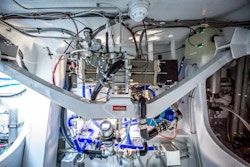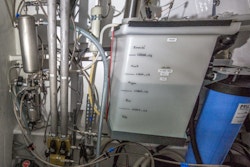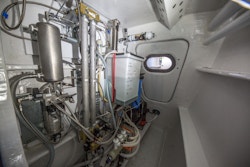Energy Observer is assessing its hydrogen system

Energy Observer hasn’t had much down time over the past few months. Since June 2017, the experimental vessel has utilized renewable energies to complete tours of France and the Mediterranean. Sixteen months of sailing and 10,326 nautical miles covered, during which its fuel cell often replaced the solar power. To start off its four-month technical revision break, assessments of the fuel cell, electrolyzer, and compressors were a necessity for Roland Reynaud, engineer on board, and Didier Bouix, engineer at the Atomic Energy Commission(CEA-Liten).
A reliable technology
“We wanted to know if the electrolyzer and compressors had aged normally. Our test consisted of measuring the time needed to fill a tank of hydrogen, going from 0 to 350 bars. At the time of commissioning, we measured exactly 20 hours for this same test.”
Test results: 20 hours and 15 minutes. Fifteen minutes difference, due to slightly different settings. The electrolyzer showed normal aging.
We were also happy to see that the polarization curve, which measures the electrolyzer’s electro-chemical characteristics, is also the same as it was at commissioning.
“We are very pleased. In terms of aging, the electrolyzer hasn’t changed at all. The 15-minute difference is caused by the filters used to ‘dry’ the moisture in the hydrogen. These filters are consumables, with a limited life-span, and are going to be changed. We also observed normal aging of the fuel cell. We have modified the settings to optimize its yield, but with no major variations.”

The CEA-Liten fuel cell
A few upgrades and modifications
The minor glitches we had with the sometimes temperamental compressor membranes this summer are currently being remedied. “The hydrogen compressors occasionally caused us problems during the last tour, confirmed Roland Reynaud. At one point, we had some inopportune ruptures in the membranes. Since then, we found a new process for starting up that works. But overall, the compressors’ characteristics haven’t changed. ”
The engineer is confident, but remains cautious in regard to this quickly-emerging technology that will undergo some improvements during the revision.
“With the forthcoming changes, the fuel cell’s efficiency will increase by 5 to 8%. ”
This fuel cell provides energy in two ways, 50% in electricity, and the other half in thermal energy, which represents up to 20 kW for Energy Observer’s on-board system.
“For now, we are only using a quarter of it, explains the technician. We are going to install a thermal storage system (editor’s note: a 500-liter water tank) that will allow us to heat the nacelle even when the battery is off. ”
The crew are delighted with this new technical improvement as they plan their upcoming tour around northern Europe…

